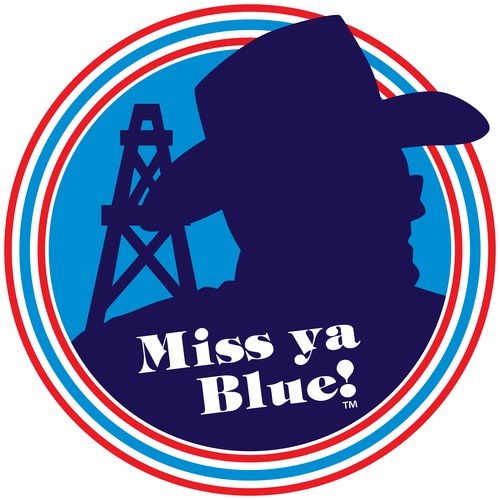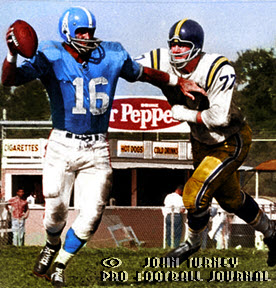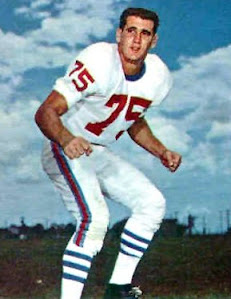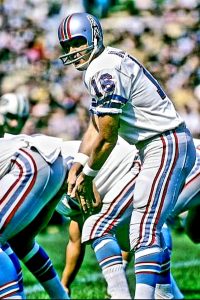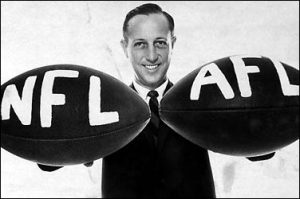COURAGE & DETERMINATION: Ed Husmann and the 1962 Houston Oilers, Part 1
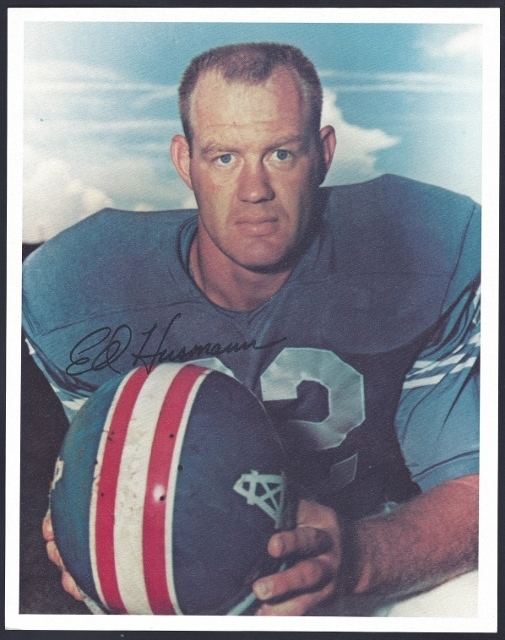
By T.J. TROUP
This article originally appeared in and is republished unabridged in two parts with special permission from Pro Football Journal, a publication dedicated to reporting mainstream and esoteric aspects of professional football. Find them on Facebook, follow them on Twitter: @NFL_Journal, and email them at profootballjournal@gmail.com.
Very similar to the saga on the 1974 Buffalo Bills, this story will be written much like my book on the 1950’s “The Birth of the Modern 4-3”. The Houston Oilers enter the ’62 campaign as the two-time AFL Champions. They also enter the season with their third head coach in three years.
No matter who is at the helm these men know how to win. Pop Ivy resigned from the Cardinals with two games to go in 1961 with a 5-7 record, yet he gets one last chance to save his coaching career. His staff includes Walt Schlinkman, who is listed as the offensive coordinator, and coaches the offensive backs. Joe Spencer in his second year has proven to be an excellent offensive line coach; especially in pass protection. New to the staff and having to fill the departed Wally Lemm’s shoes as defensive co-ordinator is Neill Armstrong.
He has a strong background having played for the Philadelphia Eagles. Pop Ivy really and truly believed in his double-wing offense in Chicago, and though entertaining; any team that fumbles and turns the ball over as much as his team did is not going to be consistently successful. Give Pop credit as he has adjusted his offense with backs not going in motion, and not losing the ball on reverse hand-offs.
Houston will align in the standard pro set, double tight end/flanker set, but quite often there is the Columbia blue-clad Oilers in the double wing and at times even a triple wing set. There is maximum pass protection with an airtight pocket for George Blanda, and of course, with a double-wing you have many options on pass routes to attack secondaries.
Running plays out of the double wing are run inside and always with trap blocking. The Oilers are still a passing team, and have a man who has undeniable faith in his ability to complete every pass and lead a team to victory in Blanda. His record-setting season of ’61 will seem like a distant memory at times in ’62 since George forces more passes than ever into coverage. No man has ever thrown 32 interceptions in eleven victories in a season at this point in pro football history, yet that is exactly what he does. Studying film of the venerable warrior he still makes the throws he needs to when it counts the most.
Blanda gets rid of the ball quickly and can read any coverage. His back-up is Jackie Lee, and the youngster can sling it with the best of them. Give me an example you ask? November 25th against the Chargers and Lee drops back into the end zone and calmly delivers a deep strike to left tight end Willard Dewveall on a seam streak for 98 yards!
Charlie Tolar can run block, pass block, catch the ball if needed, and will gain over 1,000 yards on the ground with his bowling ball style running. He is very productive on trap plays inside as he maneuvers well off the guards block. Dave Smith when given the opportunity off the bench can help any team.
Billy Cannon will not come close to his superb 1961 season, and the breakdown is as follows: first three games 45 carries for 187 yards, and the last game of the year when completely healthy 9 carries for 103 yards, but the other ten games? A pedestrian 93 carries for 184 yards.
Cannon is injured against San Diego in September and is just not the same ball carrier, yet he is one of the few backs in football that can break a game open as a receiver out of the backfield. The double wing formation is just what the doctor ordered for Billy, and as such he contributes with 13 touchdowns. Bill Groman never really recovers from his leg injury, and as such he catches 14 passes in the first half of the year, and then just 7 the second half of the campaign.
Rangy Bob McLeod is a complete tight end in that he blocks well, and is a viable weapon in the passing game. Surprising speed for a big man, he can run both short and deep routes well…..and he is consistent since he catches a pass in every game.
Willard Dewveall can play both tight end and split end, and must be accounted for on every pass play. Similar to his days with the Bears; Willard makes the difficult catch look easy, and demonstrates the ability to go over the middle and go deep. Dewveall is more than adequate as a blocker. Usually aligned as the flanker to the right is Mr. Charlie Hennigan. No receiver in football explodes out of his cuts like Charlie, and he still has blistering speed. While he drops a pass every now and then, he is reliable and his fingertip catch against the Patriots when the Oilers needed it most in November would be shown repeatedly on Sports Center.
Mr. Hennigan will not re-write the record book in ’62, yet he still ranks as one of the best in the league and forces opponents to alter coverage due to his game-breaking ability. There was no award for assistant coach of the year in the days of the AFL, but if there was—Joe Spencer would have been a finalist. Four of his offensive lineman are selected for the AFL all-star game.
Right guard Hogan Wharton is a fine pass blocker and is very effective on trap plays, and he is the one starter not selected. Center Bob Schmidt is as consistent as the day is long, and has the necessary quickness to cut-off the middle linebacker. Houston has a young quality back-up at right guard and center in John Frongillo. Right tackle Rich Michael has excellent feet, moves well and is adequate at the drive block.
Left guard Bob Talamini has gotten better every year and is now among the best in the league. Hard-nosed, and dedicated; Talamini backs down from no one. This is the last year in the league for “Dirty” Al Jamison. He has overcome his debilitating back issues and continues to battle every play. Evaluating him on film is a joy. He has average footwork and lacks quickness, but at the end of the game Dirty Al has blocked the man he is supposed to over and over again. His ability to hustle downfield and block (sometimes after the whistle) has become legendary. Not many men play in the championship game every year of their career, but his three years in the AFL have resulted in three title game appearances.
The Houston Oilers allowed just 94 yards in sacks the entire year, and this will stand as the league record until Namath and his NYJ o-line better the mark in 1966. Consider that Blanda goes down for just 39 of the 94 yards and attempts over 400 passes is a testament to his ability to get rid of the ball, and Coach Spencer’s boys keep defenders off of him. The only AFL team to not allow a sack, and not lose a fumble five times in a single season are the 1962 Houston Oilers. While the offense could not score at the record setting pace of 513 points as they did in ’61; scoring 387 is enough for the Oilers to finally win 11 games in a season.
Wally Lemm was one of the best secondary coaches in the NFL during the 1950s, and the job he did in 1961 still stands out. Wally said it best, he just “polished tarnished silver”. Wally is now with the Cardinals, yet there is an eery sameness to the Oiler defense in ’62 as what he concocted in ’61. Houston over shifts, shoots gaps, runs the zone blitz, and many times will safety blitz through one A-gap, while the middle linebacker shoots the other. Since eight men from the offense are chosen for the AFL all-star game, what does the defense have to say in this story of team success.
The first half of the year the Oilers allow 156 points, but the second half of the year—oh yeah, only 114! So, who took the field for Houston when opponents have the ball? Dennit Morris was a sullen hard-bitten take no prisoners middle linebacker for the champion ’61 Oilers, and he has retired. Houston with the 91st selection in the draft take Northwestern’s undersized Larry Onesti.
He has football savvy beyond his years, quickness, tenacity, and flows to the ball well. He starts opening day and records two sacks in the victory over Buffalo. Starting at middle linebacker at 194 lbs in the ’60s is unheard of, and Onesti lasts just four games before being injured. He is replaced by Gene Babb. Athletic, and versatile in that he has played fullback for two different NFL teams, and also linebacker; the hope is he can deliver for Houston. He is by far the weakest link on the team.
The outside linebackers fare much, much better. Right linebacker Mike Dukes is effective on the red-dog(blitz), adequate in coverage, and a strong tackler. Left linebacker Doug Cline handles tight ends well, can also red dog when asked, and is very able in pursuit. None of these men go to the all-star game.
Rookie Bobby Jancik is productive as a kick return man, and as the season progresses gets more and more playing time at right corner, and even some at left safety. Jancik has the quickness and speed to play the position, yet his season is a baptism by fire. The reason Jancik plays as much as he does is simple; Mark Johnston is not the player he was in 1960. He is the man targeted the most in the Oiler secondary. Right safety Freddie Glick is chosen for the AFL All-Star game, but does not receive any all-pro recognition. Watching him play on film is a joy. Swift, tough, and a strong tackler, he is on the verge of stardom.
Coach Armstrong uses Glick much the same way Larry Wilson is utilized in St. Louis. Left safety Jim “The Blade” Norton lacks speed, and is rail-thin, yet he is Second-team All-AFL and selected for the AFL All-Star game. Norton is a fine tackler (especially cutting runners down like a blade of grass), and has a knack for being in the right place at the right time on a pass defense.
I have been asked many, MANY times to evaluate corner play for the decade of the AFL, and there was such a revolving door for so many teams, with so many men just not having the skill set to play the position for any length of time. Tony Banfield was by far the best corner in the early days of the AFL. His athleticism, quickness, and some backpedal are what the position calls for. Though he is not Night Train Lane in stopping sweeps, Tony does not hesitate in forcing the sweep, and making the tackle. Playing the ball in flight is his strength, and has the soft hands for the interception. He is unanimous First-team All-AFL.
The second half of the 1961 season both Denver and Oakland became the doormats of the league, and as such an “equalization” draft was allowed in which teams could not keep all their players. The Houston Oilers are going to have to revamp their defensive line.
The new left defensive end is Gary Cutsinger, and is going to be a real fine strong side defensive end when he gains experience. Cutsinger holds up admirably during ’62. Late in the year 5’10” Bucky Wegener plays defensive end and in the title game, he is one the best players on the field. Though he plays in only four games Ron McDole also shows flashes of ability (especially against New York).
Ed Culpepper knows all about losing having played for the Chicago Cardinals and the expansion Minnesota Vikings. Still strong as a run plugger, Ed also is a factor in rushing the passer in ’62. Rotating in with Ed is veteran Bill Herchman. While not very effective as a pass rusher, he and Culpepper hold up well in ’62.
Right defensive end Don Floyd is unanimous First-team All-AFL. He sheds blocks well, has the skill set to rush the passer, and is able in pursuit.
NEXT WEEK – Part 2 of “COURAGE & DETERMINATION: Ed Husmann and the 1962 Houston Oilers”
#houston #oilers #htown #houstontx #houstonoilers #nfl #astrodome #sports #star #history #football #luvyablue #missyablue #texas #houstonblogger
